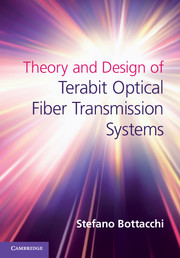Book contents
- Frontmatter
- Dedication
- Contents
- Preface
- Acknowledgments
- Part I Signals, spectra and optical modulations
- Part II Principles of light polarization and optical amplification
- 4 Principles of non-linear optics and light polarization
- 5 Principles of light amplification
- 6 Spectral gain modeling of optical amplifiers
- 7 Noise theory of optical amplifiers
- Part III Interferometric optical modulators
- Part IV
- Appendix A Electromagnetic energy and power flow
- Appendix B Optical power and photon flux
- Index
- References
5 - Principles of light amplification
Enabling optical amplifier technologies for terabit transmission
from Part II - Principles of light polarization and optical amplification
Published online by Cambridge University Press: 05 September 2014
- Frontmatter
- Dedication
- Contents
- Preface
- Acknowledgments
- Part I Signals, spectra and optical modulations
- Part II Principles of light polarization and optical amplification
- 4 Principles of non-linear optics and light polarization
- 5 Principles of light amplification
- 6 Spectral gain modeling of optical amplifiers
- 7 Noise theory of optical amplifiers
- Part III Interferometric optical modulators
- Part IV
- Appendix A Electromagnetic energy and power flow
- Appendix B Optical power and photon flux
- Index
- References
Summary
Introduction
Most of the lightwave transmission systems operating today benefit fully from extensive deployment of optical amplifiers (OA). These components perform the amplification of optical intensity directly in the optical domain, without resorting to any electrical-domain regeneration. Optical amplifiers increase the average number of output photons per unit time by several orders of magnitude compared with the incoming signal intensity. However, as with every amplifying process, optical amplification cannot be achieved without paying back for the unavoidable noise power added to the signal intensity. As we will see in detail in Chapter 6, the optical amplification process comes with optical noise generated by spontaneous emission inside the active medium. The intensity of the optical signal is represented by the flux of the signal photon population. Conversely, the photons generated by the spontaneous emission process inside the optical cavity represent the noise photon population. The fundamental phenomenon supporting optical amplification is stimulated emission. The basic property of stimulated emission, making the great difference from spontaneous emission and enabling optical amplification, is the coherent nature of the photon generation process. Accordingly, both signal and noise photons go through the same multiplication process by means of stimulated emission. Unless the optical cavity where the stimulated emission takes place (the active cavity) presents selective features for enhancing the signal photon population relative to the spontaneous one, there is no way to avoid noise photons going through stimulated emission, filling most of the cavity population. As a consequence, both photon populations increase, leading respectively to amplified signal intensity and to amplified spontaneous emission intensity. It should be apparent that every noise photon can create a new identical noise photon as a result of stimulated emission, effectively increasing the noise intensity in the active optical cavity. This is the well-known mechanism of amplified spontaneous emission (ASE) noise in optical amplification. Any improvement in the optical amplifier structure devoted to increasing stimulated over spontaneous emission will probably increase the optical signal-to-noise ratio (OSNR) at the cavity output. The spectrum of gain characteristic of the optical active medium is usually wide enough to support an efficient amplification of the broadband spontaneous emission spectrum, leading to the broadband ASE noise power spectral density.
- Type
- Chapter
- Information
- Theory and Design of Terabit Optical Fiber Transmission Systems , pp. 299 - 373Publisher: Cambridge University PressPrint publication year: 2014



